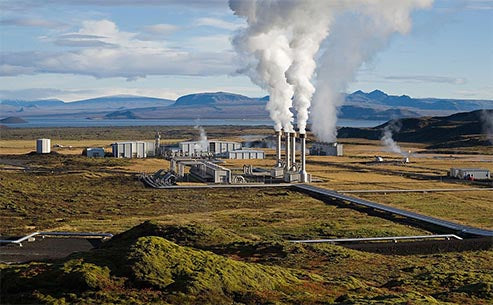
Geothermal is one of the most realistic and competitive energy sources in the new energy family. It is estimated that the amount of recoverable sources of geothermal energy in the world has exceeded the annual consumption of global primary energy (400EJ/a), and the development and utilization of geothermal energy resources has great potential.
According to the statistics of the International Geothermal Association (IGA), as of 2005, 24 countries around the world have been conducting geothermal power generation, with a total installed capacity of 8,900MW. The total installed capacity and annual production value of the 71 countries engaged in the direct utilization of geothermal energy have reached 27,825MWt and 72,622GWh, respectively. Using current technology, it is possible to increase the existing 10GW of the world's total geothermal power generation to 70GW in 2050, and to 140GW if technology is innovative. If geothermal power replaces natural gas, it can reduce potential 500 million tons of CO2 emissions per year, and if it replaces coal, it can reduce 1 billion tons. With current technology, it is quite possible to increase the capacity of geothermal direct utilization from the current 60GWth to 800GWth by 2050, 90% of which will be heat pump systems, because in most parts of the world it can be used to simultaneously meet heating and cooling needs .
In 2050, direct use of geothermal energy could reduce a potential 300 million tCO2 emissions per year. If the pump input power is supplied by a renewable energy source such as hydro, wind or geothermal energy, the reduction in emissions will be even greater. In 2004, the top 10 countries of geothermal direct utilization were ranked as China 12.605GWh/a, Sweden ro.000Gwh/a, the United States 8.678GWh/a, Turkey 6.900GWh/a, Iceland 6.806Wh/a, Japan 2.862GWh/a, Hungary 2.206 GWh/a, Italy 2.098GWh/a, New Zealand 1.968GWh/a, Brazil 1.840GWh/a.

Geothermal Energy
China is a country dominated by medium and low temperature geothermal resources. At present, the direct development and utilization of non-electricity has ranked first in the world (installed capacity and annual production value reached 3687Mwt and 12605GWh respectively). Geothermal power generation is relatively small in China. The largest Tibet Yangbajing Geothermal Power Station has a total installed capacity of only 25.18MW, but it once provided 50% of Lhasa’s electricity supply (up to 60% in winter). It currently accounts for 13% of China's power grid. In addition to Yangbajing Geothermal Power Station, Tibet has also built Langjiu 2MW and Naqu 1MW Geothermal Power Plants, but they have been shut down due to scaling problems. In addition, medium and low temperature geothermal power stations: Dengwu 300kw in Fengshun, Guangdong and 300kw in Ningxiangtang, Hunan have both been running for more than 30 years.
The utilization of geothermal resources in China has a long history, but the real large-scale exploration and development and utilization began in the early 1970s, especially since the 1990s, driven by the needs of the market economy, the development and utilization of geothermal resources has been more vigorously developed . In recent years, with the development of social economy, scientific and technological progress and the improvement of people's understanding of geothermal resources, there has been an upsurge in the development and utilization of geothermal resources, with an average annual growth rate of 12%. By the end of 2005, the annual direct utilization of geothermal resources in China had reached 445.7 million m³, ranking first in the world. By 2010, it is estimated that the total amount of geothermal water mined annually will reach 900 × 106 m³, and the amount of heat extracted and utilized is equivalent to about 495% of standard coal. ×104t/d. At present, the development and utilization of geothermal resources in China has reached a certain scale in terms of heating, hot water supply, medical care, bathing, recreational greenhouse, planting, breeding and industrial applications, among which heating and heating account for 18.0%, and medical bathing and entertainment and fitness account for 65.2%. , planting and breeding accounted for 9.1%, and others accounted for 7.7%, initially forming a geothermal industry with Chinese characteristics. However, the development and utilization of geothermal energy in China is still in its infancy, and the proportion of geothermal energy in the energy structure is less than 0.5%.
While great achievements have been made in the development and utilization of geothermal resources in China, there are still some problems: the level of resource development and utilization is not high, the recovery rate of geothermal resources is low, the temperature of abandoned water is high, and the management of geothermal resources development and utilization is relatively chaotic. In the stage of decentralized and extensive operation, a unified national geothermal dynamic monitoring network has not been established, and even some places still have the phenomenon of blind exploitation. The geothermal resource exploration and development market is still in its infancy, and the utilization of geothermal resources in most areas is relatively simple and wasteful. , focusing on development and neglecting protection, resulting in ground subsidence and serious environmental pollution.















